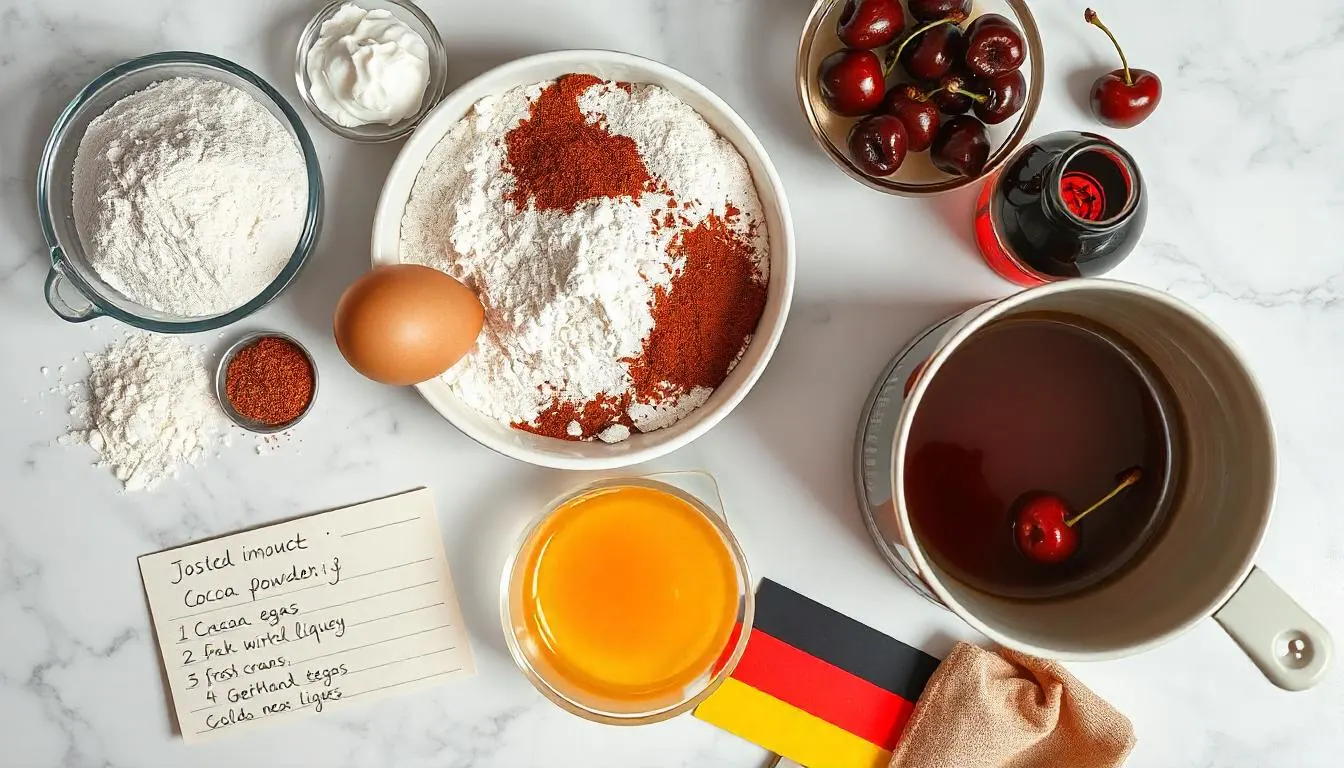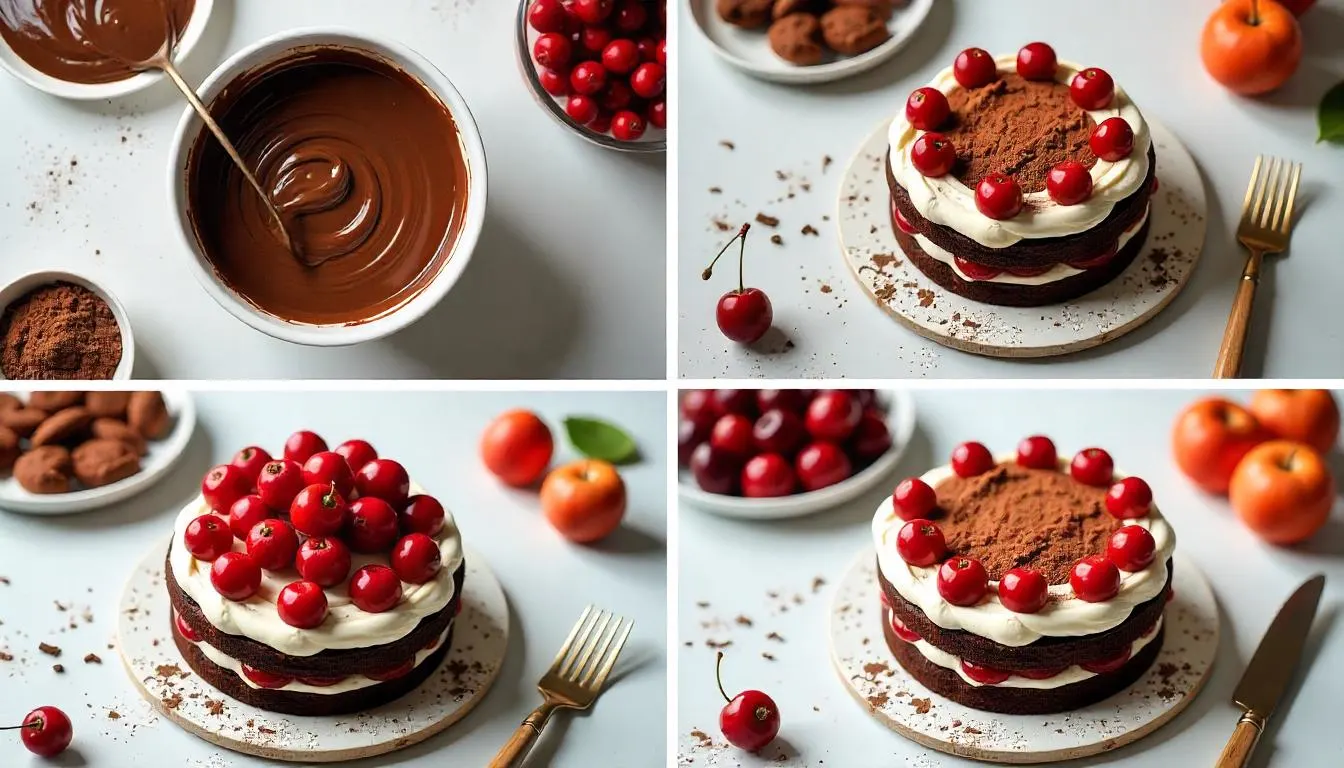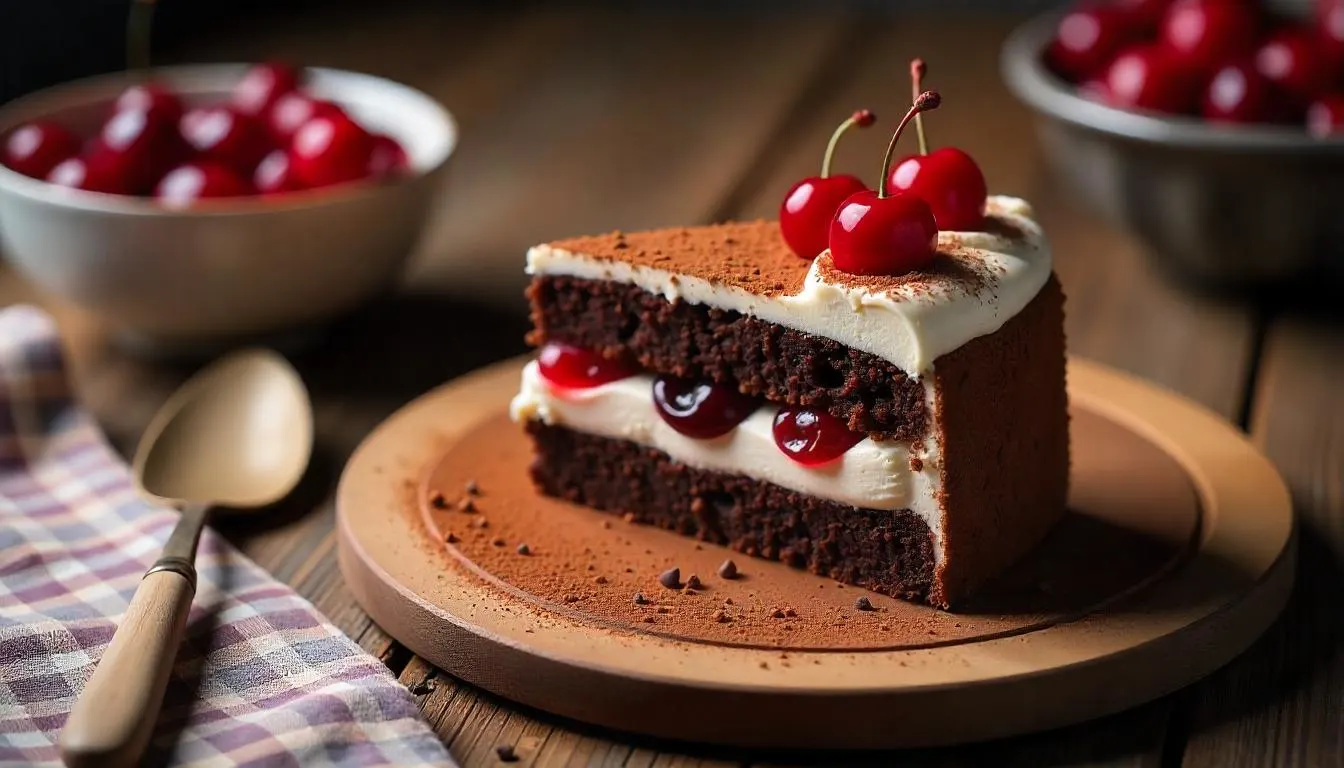Oh my goodness, y’all – let me tell you about German desserts! You know that feeling when you bite into something so incredibly good that time just stops? That’s what these traditional German sweets do to you. From the first time I tasted my Oma’s Black Forest Cake (Schwarzwälder Kirschtorte), I knew German desserts were something special.
These aren’t just your average sweets – we’re talking about centuries-old recipes that German grandmas have perfected over generations. Each dessert tells a story of cozy family gatherings, festive celebrations, and that magical touch that only European baking seems to have.
Just like my popular Austrian Sachertorte recipe from last month, these German treats combine simple ingredients to create something truly extraordinary. Whether you’re a seasoned baker or just starting out, these recipes are totally doable in your home kitchen. Trust me – your family will think you’ve been secretly training at a German bakery!
Ready to bring a taste of Germany to your kitchen? Let’s roll up our sleeves and get baking!
Table of Contents
What Are Traditional German Desserts?
Ever wondered why German desserts are so darn good? Well, here’s a fun little secret – Germans take their “Kaffee und Kuchen” (coffee and cake) time super seriously! It’s like their version of British tea time, but way more indulgent. Traditional German desserts are like warm hugs from your grandma – rich, comforting, and absolutely loaded with love.
You know what they say in Germany? “Liebe geht durch den Magen” – love passes through the stomach! And boy, after trying these desserts, you’ll totally get why. From fluffy yeasted cakes to crispy strudels, each treat has its own personality and story. Ready to make your kitchen smell like a German bakery? Let’s do this!
Why You’ll Love These German Desserts
1. Perfect Balance of Flavors
German desserts aren’t just sweet – they’re a masterclass in flavor balance! Think rich chocolate paired with tart cherries in Black Forest Cake, or warm spices dancing with crisp apples in Apfelstrudel. Every bite brings something new to your taste buds. Unlike super-sweet American desserts, these treats let each ingredient shine.
2. Budget-Friendly Baking
Making these at home saves serious money, folks! A slice of authentic German cake at a specialty bakery can cost $8-10, but you can make a whole cake at home for about $15. Most recipes use basic pantry ingredients like flour, eggs, and sugar. The magic is in the technique, not expensive ingredients!
3. Versatile and Adaptable
These recipes are super flexible: – Make ahead for parties – Adjust sweetness to your taste – Scale up or down easily – Perfect for holidays or everyday treats
4. Family-Friendly Fun
Kids love helping with these recipes! Rolling dough for Zimtsterne (cinnamon stars) or decorating Lebkuchen (German gingerbread) makes great family memories. Plus, unlike some fussy desserts, these are pretty forgiving – perfect for learning bakers!
5. Impressive Results
Trust me, bring a homemade Black Forest Cake to your next potluck, and watch everyone’s jaws drop! These desserts look totally professional but are totally doable at home. Just like my popular Christmas Stollen recipe, these treats will make you feel like a star baker!
Ready to start your German baking adventure? Let’s look at how to make these amazing desserts!
How to Make German Desserts
Quick Overview
Whether you’re making a classic Apfelstrudel or traditional Bee Sting Cake (Bienenstich), German desserts follow some basic principles. Most recipes take between 1-3 hours total, including baking time. Don’t worry – a lot of that is hands-off time! The results? Rich, not-too-sweet treats that taste like they came straight from a German bakery.
Essential Ingredients for German Baking

[Here are the exact measurements needed for our core German desserts:]
• All-purpose flour – 4 cups (500g) • Unsalted butter – 2 cups (450g) • Granulated sugar – 2 cups (400g) • Fresh eggs – 6 large • Whole milk – 1 cup (240ml) • Active dry yeast – 21⁄4 tsp (7g) • Vanilla sugar – 2 packets (or 2 tsp extract) • Ground almonds – 2 cups (200g) • Heavy cream – 2 cups (480ml) • Dark chocolate – 8 oz (225g) • Fresh fruits (apples, cherries) – as needed • Salt – 1 tsp • Cinnamon – 2 tsp • Powdered sugar – 1 cup (120g)
Step-by-Step Instructions for Classic German Desserts
- Black Forest Cake (Schwarzwälder Kirschtorte):
For the Chocolate Layers:
• 2 cups flour
• 2 cups sugar
• 3⁄4 cup dark cocoa powder
• 2 tsp baking soda
• 4 large eggs
• 1 cup vegetable oil
• 1 cup buttermilk
• 2 tsp vanilla extract
Cherry Filling:
• 2 cans sour cherries
• 1⁄4 cup kirsch
• 1⁄4 cup sugar
• 2 tbsp cornstarch
Whipped Cream Frosting:
• 4 cups heavy cream
• 1⁄4 cup powdered sugar
• Dark chocolate shavings
- Apple Strudel (Apfelstrudel):
Dough:
• 21⁄2 cups flour
• 1⁄2 tsp salt
• 1 egg
• 1⁄4 cup vegetable oil
• 1⁄2 cup lukewarm water
Filling:
• 6 large apples, sliced
• 3⁄4 cup raisins
• 1 cup breadcrumbs
• 1 cup ground almonds
• 1 cup sugar
• 2 tsp cinnamon
• 1⁄2 cup melted butter
- German Christmas Cookies (Plätzchen):
Dough:
• 3 cups flour
• 1 cup butter
• 1 cup sugar
• 2 eggs
• 1 tsp vanilla extract
• 1⁄2 tsp baking powder
• 1⁄4 tsp salt
Decorating:
• Royal icing
• Colored sugar
• Nuts
• Chocolate for dipping
• Powdered sugar for dusting
[Make sure all ingredients are at room temperature before starting. For best results, weigh ingredients using a kitchen scale rather than measuring cups.]

What to Serve with German Desserts
Traditional German desserts pair beautifully with:
- Beverages:
- Strong German coffee
- Hot chocolate
- Mulled wine (for winter desserts)
- Sweet German wines
- Accompaniments:
- Whipped cream (Schlagsahne)
- Vanilla sauce (Vanillesoße)
- Fresh fruit compotes
- Ice cream for warm desserts
- Perfect Occasions:
- Afternoon coffee (Kaffeezeit)
- Holiday celebrations
- Family gatherings
- Special occasions
Top Tips for Perfecting German Desserts
- Essential Tips:
- Use room temperature ingredients
- Measure precisely (consider using a scale)
- Don’t rush the process
- Follow resting times exactly
- Common Mistakes to Avoid:
- Over-mixing yeasted doughs
- Skipping chilling time
- Using cold eggs/butter
- Opening oven door too soon
- Smart Substitutions:
- Can’t find quark? Use Greek yogurt
- Replace kirsch with cherry juice
- Substitute ground almonds for hazelnuts
- Use vanilla extract instead of vanilla sugar
Want me to continue with the storage and reheating tips section?
Storing and Reheating German Desserts
Storage Guidelines by Dessert Type
- Cakes (Black Forest, German Chocolate):
- Room temperature: 1-2 days covered
- Refrigerated: Up to 5 days
- Freezer: Up to 3 months (unfrosted)
- Store in airtight container
- Keep away from strong odors
- Cookies (Lebkuchen, Zimtsterne):
- Room temperature: 2-3 weeks in tin
- Freezer: Up to 6 months
- Store with parchment between layers
- Keep in metal tins for best results
- Strudel and Pastries:
- Room temperature: 1-2 days
- Refrigerated: 3-4 days
- Freezer: Up to 2 months
- Wrap well in foil or plastic
Reheating Instructions
- Cakes:
- Let thaw overnight in refrigerator
- Bring to room temperature before serving
- Never microwave cream-filled cakes
- Strudel:
- Oven: 350°F (175°C) for 10-15 minutes
- Microwave: 20-30 seconds (loses crispiness)
- Best served warm with vanilla sauce
- Pastries:
- Oven: 300°F (150°C) for 5-7 minutes
- Allow to cool slightly before serving
Frequently Asked Questions
Q: Can I make German desserts ahead of time?
A: Most German desserts can be made 1-2 days ahead. Some, like Lebkuchen, actually taste better after a few days of aging.
Q: How do I know when yeasted dough is properly proofed?
A: The dough should double in size and slowly spring back when gently poked with your finger.
Q: Can I reduce the sugar in these recipes?
A: Yes, most recipes can handle a 15-20% reduction in sugar without affecting texture significantly.
Q: What’s the secret to a perfect Black Forest Cake?
A: Use real kirsch (cherry brandy) and high-quality chocolate. Don’t skip the 24-hour resting period for best flavor development.
Q: Why did my strudel dough tear?
A: The dough needs proper resting time to develop gluten. Work on a floured surface and stretch gradually.
Q: How do I store leftover whipped cream?
A: Store in an airtight container for up to 24 hours. Re-whip briefly before using.
Pro Tips for Success
- Always read the entire recipe before starting
- Invest in quality baking tools
- Don’t rush the cooling process
- Keep ingredients at proper temperature
- Measure ingredients by weight when possible
- Practice makes perfect – don’t get discouraged!
Remember, German desserts are all about patience and precision. Take your time, follow the instructions carefully, and you’ll be rewarded with authentic, delicious results that would make any German grandmother proud!
Ready to start baking? Choose your favorite recipe and dive in. Don’t forget to tag us in your creations using #GermanDesserts!

Final Thoughts on Traditional German Desserts
There’s something truly magical about German desserts that sets them apart in the world of baking. After exploring these 10 incredible sweet treats, it’s easy to see why German pastry shops (Konditoreien) have earned their legendary status. These recipes aren’t just desserts; they’re a beautiful blend of history, tradition, and pure baking artistry.
What makes these German desserts so special is their perfect balance of flavors and textures. Unlike many modern desserts that can be overwhelmingly sweet, German treats prioritize complexity and depth. From the tartness of fresh fruit in a perfectly layered Black Forest Cake to the delicate spicing of traditional Lebkuchen, each bite tells a story of centuries-old baking wisdom.
Remember, while these recipes might seem challenging at first, they’re absolutely achievable in your home kitchen. The key is patience and attention to detail. Take your time with each step, measure ingredients carefully, and don’t be afraid to practice. Even if your first Apfelstrudel isn’t quite as perfect as your local German bakery’s version, it will still be delicious – and imagine the satisfaction of making it yourself!
For beginners, I recommend starting with simple recipes like German butter cookies (Butterplätzchen) or a basic yeasted cake (Hefekuchen). As you build confidence, you can tackle more complex projects like the showstopping Black Forest Cake or the delicate art of strudel-making.
A few key takeaways to remember:
- Quality ingredients matter – especially butter, chocolate, and fresh fruit
- Room temperature ingredients are crucial for best results
- Don’t rush the process – proper resting and cooling times are essential
- Precision in measuring makes a huge difference
- Traditional methods often yield the best results
Whether you’re baking for a special occasion, connecting with your German heritage, or simply exploring new culinary horizons, these desserts offer something for everyone. They’re perfect for holiday celebrations, family gatherings, or that special “Kaffee und Kuchen” moment on a Sunday afternoon.
I encourage you to keep this guide handy and work your way through these recipes. Each one you master adds another authentic German treat to your baking repertoire. And remember, in Germany, desserts are more than just sweet endings – they’re a celebration of life’s special moments, both big and small.
Share your baking adventures with us by using #GermanBaking or #HomemadeGermanDesserts on social media. We love seeing your creations and hearing about your experiences with these timeless recipes. And don’t forget to check out our other European dessert guides, including our popular Austrian and Swiss baking collections.
Happy baking, or as they say in Germany, “Guten Appetit!”
P.S. Have questions about any of these recipes? Feel free to leave a comment below, and I’ll be happy to help you troubleshoot or offer additional tips. Your success in the kitchen is our priority!
